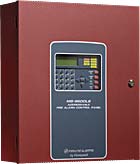Better ROI with 'Same' Wires

New addressable fire systems use unshielded, untwisted wire, more typical in conventional systems. The ROI is significant. Photo courtesy: LiteSpeed from Fire-Lite
New fire system technology, using unshielded, untwisted wire, will bring better return on investment for enterprises.
The fire alarm panel is the heart of the system, and modern addressable panels can provide superior precision in identifying the source of a fire. Newer models are also adept at extracting vital information from detection devices indicating device status (alarm/trouble), smoke levels (normal/pre-alarm/alarm), dust accumulation (clean versus dirty) and the integrity of the device’s electronic
New panel, new wiring
While a business may feel comfortable with the cost of a new intelligent addressable system, the fact remains that the bulk of a fire protection system’s cost lies in the installation, from both a labor and parts perspective. With retrofit applications, the bulk of that financial burden stems from the considerable rewiring.Conventional fire alarm systems use single conductors of 12-gauge unshielded, untwisted copper wire, or THHN, as their foundation. Conversely, many addressable systems connect via twisted, shielded wire. This consists of two conductors in the same jacket and often they carry an internal foil shield. Consequently, the switch from a conventional to an addressable system necessitates significant rewiring. Add to this the concern that can result when the wiring is being done in existing walls and ceilings rather than new construction, and neither the business owner nor the electrician doing the work are going to sleep very well.
New systems, however, will soon be offering addressable systems that can use the same unshielded, untwisted wire employed by conventional systems. The financial ramifications for enterprises and their security operations are noteworthy. A business can switch from a conventional to an addressable system by simply removing the old detector heads and installing a new detector base, using virtually all of the existing wiring.
But the positive economic news doesn’t end there. If an enterprise feels that, despite the wiring, an addressable system is still fiscally out of reach, it can be done with a phased approach, that is, the addressable panel can be installed, leaving the old conventional heads on the conventional loop, and still be monitored via addressable monitor modules. The monitor modules will supervise the older conventional loops and, if any smoke detector or signaling device on the loop is activated, the monitor module will relay the information over the addressable communications circuit to the new panel. The loops can be replaced, one at a time if need be, as time and budget allow.
Meeting demands
The ability to use existing wiring is a significant benefit of the new panel technology in the context of new UL requirements, an outgrowth of guidelines set forth by organizations like the National Fire Protection Association. Ultimately, the new requirements reflect the improved standards and forward-thinking approaches that the fire-protection industry as a whole seeks to embrace.It quickly became apparent that in order to get around a large system in a short period of time, it would be necessary to create an entirely new polling protocol. The requirement stated that notification circuits, which contain horns, speakers and strobe lights, must be activated within 10 seconds from the time of indication (i.e., a detector sensing smoke).
Using such new technology as a catalyst, new equipment devices are used solely as data collectors; the alarm is not processed in the device head, but rather in the control panel, based on the digital data values sent by the device. Adding a system-wide feature requires some simple reprogramming and updating to the panel software.
Once all the devices are addressed and connected, an installer simply touches the Auto Program button. The system sends out a signal that will locate and identify all attached devices. If there is a problem with a device, or even if two devices are similarly addressed (convincing the system that there is a duplicate and consequently unnecessary device), the system will find it in a hurry. This allows the installing dealer to provide a working fire alarm system to a building owner very quickly, and allows a certificate of occupancy to be issued by the authority having jurisdiction.
The benefit of such modularity cannot be overstated. For years, various trades (drywallers, painters, etc.) have inflicted damage on fire alarm panels, albeit unintentionally. Owing to new designs, damaged electronics can be avoided. Wires are pulled and tagged or even installed on the removable wire connectors. V
Looking for a reprint of this article?
From high-res PDFs to custom plaques, order your copy today!





